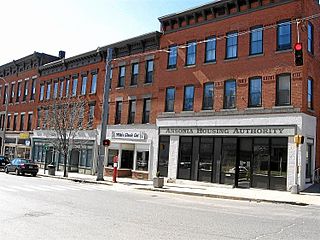
New Castle is a city in New Castle County, Delaware, United States. The city is located six miles (10 km) south of Wilmington and is situated on the Delaware River. As of 2020, the city's population was 5,551. New Castle constitutes part of the Delaware Valley or Philadelphia metropolitan area.

Wilmington is the largest city in the U.S. state of Delaware. The city was built on the site of Fort Christina, the first Swedish settlement in North America. It lies at the confluence of the Christina River and Brandywine Creek, near where the Christina flows into the Delaware River. It is the county seat of New Castle County and one of the major cities in the Delaware Valley metropolitan area. Wilmington was named by Proprietor Thomas Penn after his friend Spencer Compton, Earl of Wilmington, who was prime minister during the reign of George II of Great Britain.

Brandywine Creek is a tributary of the Christina River in southeastern Pennsylvania and northern Delaware in the United States. The Lower Brandywine is 20.4 miles (32.8 km) long and is a designated Pennsylvania Scenic River with several tributary streams. The East Branch and West Branch of the creek originate within 2 miles (3 km) of each other on the slopes of Welsh Mountain in Honey Brook Township, Pennsylvania, about 20 miles (32 km) northwest of their confluence.

The Grand Circus Park Historic District contains the 5-acre (2.0 ha) Grand Circus Park in Downtown Detroit, Michigan that connects the theatre district with its financial district. It is bisected by Woodward Avenue, four blocks north of Campus Martius Park, and is roughly bounded by Clifford, John R. and Adams Streets. The district was listed on the National Register of Historic Places in 1983. The building at 25 West Elizabeth Street was added to the district in 2000, and additional structures located within the district, but built between 1932 and 1960, were approved for inclusion in 2012.

Downtown Grand Forks is the original commercial center of Grand Forks, North Dakota, United States. Located on the western bank of the Red River of the North, the downtown neighborhood is situated near the fork of the Red River and the Red Lake River. While downtown is no longer the dominant commercial area of the Greater Grand Forks community, it remains the historic center of Grand Forks. An 80.4-acre (32.5 ha) portion was listed on the National Register of Historic Places in 2005, as Downtown Grand Forks Historic District. Today, downtown Grand Forks is home to many offices, stores, restaurants, and bars.

The Grand Opera House, also known as The Grand or Masonic Hall and Grand Theater, is a 1,208-seat theater for the performing arts in Wilmington, Delaware, United States. The four-story building was built in 1871 by the Delaware Grand Lodge of Masons to serve as a Masonic Temple and auditorium. The construction cost was $100,000. It was designed in Second Empire style by Baltimore architect Thomas Dixon and incorporates symbolism from Freemasonry into the cast-iron facade. Its central pediment contains an Eye of Providence.

This is a list of the National Register of Historic Places listings in Detroit, Michigan.

The F. W. Woolworth Company Building is a historic department store building located in downtown Wilmington, Delaware.

The DuPont Building, occupying the entire block bound by 10th, 11th, Orange and Market streets, was one of the first high-rises in Wilmington, Delaware, United States. It looks out over Rodney Square. The building was built in phases, with the original building constructed in 1908 fronting Rodney Square. At the time, the building housed the offices of DuPont. In 1913, the building was expanded into a "U" by adding wings along 10th and 11th streets, the DuPont Playhouse was added, and a portion of the original 1908 section was converted into the Hotel du Pont. The final addition to the building occurred in 1923 when the Orange Street addition was added along with an additional two floors, bringing the floor count to 13 and the height to 124 feet (38 m).

The Delaware Historical Society began in 1864 as an effort to preserve documents from the Civil War. Since then, it has expanded into a statewide historical institution with several buildings, including Old Town Hall and the Delaware History Museum, in Wilmington and the historic Read House & Gardens in New Castle.
John W. McKecknie (1862–1934) was an American architect working in Kansas City, Missouri, who applied the principles of reinforced concrete in the construction of commercial structures clad in a repertory of classical motifs. He produced designs for some 120 commercial buildings, residences and apartment blocks, establishing the monumental character of West Armour Boulevard with more than a dozen colonnaded apartment blocks. Several of his structures are now registered in the National Register of Historic Places, and others contribute to their Historic District designations.

Crosby and Hill Building is a historic commercial building located at Wilmington, New Castle County, Delaware. It was built about 1859, with the present facade added in 1920.

Govatos'/McVey Building is a historic commercial building located at Wilmington, New Castle County, Delaware. It was built in 1895, and is a three-story, rectangular plan building of bearing wall brick construction. During the first half of the 20th century, it was converted into a restaurant, candy factory/shop by removing original storefronts along East Eighth Street. The building features large half-hexagonal pedimented copper bays on the second and third stories in the Queen Anne style. The building has housed Govatos Chocolates since 1910–1918. Govatos is the last candy making firm in Wilmington and still makes hand-dipped candy by the same method as in 1894.

Max Keil Building is a historic commercial building located at Wilmington, New Castle County, Delaware. It was built about 1850, and modified in the Art Moderne / Art Deco style in 1938. It is a three-story, single-bay commercial building with a rectangular plan built of wall bearing brick construction. The front facade features a large curved glass display window on the first floor and an austere, peach-colored terra-cotta wall with a large rectangular window of structural glass block at the second and third floors.

Max Keil Building is a historic commercial building located at Wilmington, New Castle County, Delaware. It was built about 1875, and modified in the Art Moderne/Art Deco style in 1938. It is a three-story, single-bay commercial building with a rectangular plan built of wall bearing brick construction. The front facade features large display windows on the first floor and an austere, peach-colored terra-cotta wall with a large rectangular display window at the second and third floors. In 2010, it was occupied by an outlet of Rainbow Shops.

Lower Market Street Historic District is a national historic district located at Wilmington, New Castle County, Delaware. It encompasses 132 contributing buildings the central business district of Wilmington. It includes attached commercial and commercial/residential structures dating from the mid-18th to the early-20th century. The buildings reflect a variety of popular architectural styles including Classical Revival, Greek Revival, Federal, and Art Deco. Notable buildings include the Farmers Bank (1912), Jake's Market, Wilmington and Brandywine Bank, Joshua Conner and Sons, J.T. Montgomery Jewelry Store, and Wilmington Publishing Company Building.

The Waterville Main Street Historic District encompasses the best-preserved portions of the historical commercial downtown area of Waterville, Maine. Developed most intensively in the late 19th and early 20th centuries, this area was the center of commerce for Waterville and the surrounding rural communities. It encompasses 25 properties on Main and Common Streets, including the Waterville Opera House and City Hall. It was listed on the National Register of Historic Places in 2012, and was slightly enlarged in 2016.

The Clare Downtown Historic District is a collection of 51 buildings located along four blocks of North McEwan Street in Clare, Michigan, along with adjacent portions of East and West Fourth Street and East and West Fifth Street. Street addresses of the structures run from 307 to 622 North McEwan, 114-120 East Fifth Street, 102-202 West Fifth Street, 112-115 East Fourth Street, and 112-124 West Fourth Street. The district was listed on the National Register of Historic Places in 2016.

The Upper Main Street Historic District encompasses a collection of mainly late-19th-century commercial buildings on Main Street in downtown Ansonia, Connecticut. Extending south from Maple Street, the district exemplifies the rapid commercial growth of the city at that time. Its most prominent feature is the Ansonia Opera House, built 1870. The district was listed on the National Register of Historic Places in 1982.

The Delmarva Power & Light Building, also known as the DCAD Building, is a historic office building in downtown Wilmington, Delaware. The former headquarters of Delmarva Power & Light (DP&L) is listed on the National Register of Historic Places.
























